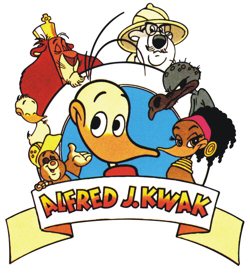Stip
| Stip | |
|---|---|
| Character | |
 | |
| Stip in Episode 1 | |
| Species | Heron |
| Birthplace | Unknown |
| First appearance | Episode 1 |
| Character Model Sheet number | 2/1[1] |
| Character Model Sheet name | Stip, Stap |
Name in different languages | |
| Dutch name | Stip |
| Japanese name | スティップ (Sutippu) |
| German name | Stip |
| English name | Strip |
Employed by the Beton Maatschappij[2], Stip and his colleague Stap are surveyors measuring the Plaspoelpolder so that Olaf Nijlpaard and Alfons Rokodil can construct Groot Speelgoedland there. It is unknown whether Stip and Stap are related by blood.[3]
Appearance
Stip is a relatively tall and slender heron with long backhairs. He has short wings and does not wear any clothing.[1][3]
His design in the book De wonderlijke avonturen van de eend Alfred Jodocus Kwak: Goedemorgen differs slightly, featuring a longer upper body and shorter legs. Additionally, his knees bend at the midpoint of his legs instead of higher up. In his first of two appearances in the book, he wears a black and yellow armband.[4][5]
Personality
On Stip's character sheet, he appears proud and content with his job. In the animated series, his limited screen time prevents a clear display of personality. However, in De wonderlijke avonturen van de eend Alfred Jodocus Kwak: Goedemorgen, he is at least shown to be polite towards Johan Sebastiaan Kwak.[3][4]
In De Droom van Alfred Jodocus Kwak, Stip and his colleague Stap both ask Johan to relocate.[6] Even after construction of Groot Speelgoedland had begun, Stip and Stap continued pressuring Johan and his family to move, asking them twice in the middle of the night.[7]
Storyline
Stip and his colleague Stap survey the pastures of the Plaspoelpolder in Breed Rietland, where they encounter Johan Sebastiaan Kwak daydreaming about his crush, Anna van de Polder. They ask him to relocate from his spot.[3][4][6]
Their surveying efforts lead to the creation of a miniature model of the polder, commissioned by Olaf Nijlpaard. This model features a tiny representation of a planned theme park, Groot Speelgoedland. Olaf Nijlpaard uses their model to persuade Kaspar Rokodil to finance the project and convinces Bart 'Bever' Beton, head of the Beton Maatschappij, to undertake its construction. Stip and Stap are permitted to attend the meeting where these decisions are made.[3][5]
During the construction of the theme park, Stip and Stap were required to continue their surveying late into the night. This led them to repeatedly request that local residents, including Johan Sebastiaan Kwak, Anna van de Polder, and their family, vacate their home, asking them to move twice.[7]
Voice actors
| Japanese | ¦ | Silent | ¦ | スティップ (Sutippu) |
| Dutch | ¦ | Silent | ¦ | Stip |
| German | ¦ | Silent | ¦ | Stip |
| English | ¦ | Silent | ¦ | Strip |
Appearances
TV Series
Audio
Books
-
De wonderlijke avonturen van Alfred J. Kwak: De zeven eieren (1989) (Dutch)
-
De wonderlijke avonturen van Alfred J. Kwak: Omnibus 1 (1989) (Dutch)
-
Alfred J. Kwak Mijn avontuurlijke leven (1991) (Dutch)
-
Alfred J. Kwak Filmstripboek Deel 1 (2006) (Dutch)
Production background
Stip and his colleague Stap were both part of the original outline written by Herman van Veen and were explicitly named in that document. They share a character sheet, with Stip labeled as (2/1) and Stap as (3/1). A visual gag depicted on the sheet, but unused in the animated series, highlights their contrasting heights: while Stip is significantly taller than Stap, he holds a much shorter measuring stick, whereas Stap carries one that is nearly as tall as Stip. The character sheet was created in April 1988.[1]
Stip's name translates to "dot" in Dutch, while Stap's name translates to "step." This naming convention references their roles as surveyors, as they systematically mark dots on a map at measured steps. Most other languages retain these names, even though their original meaning is obscured.
In the English dub, their names are changed to Strip and Strap, introducing a new interpretation. However, this change does not carry the same thematic significance as the original Dutch names.

References
- ↑ 1.0 1.1 1.2
Siepermann, Harald; Bacher, Hans (1988). Character- and Color-Designs for Alfred J. Kwak. Duesseldorf - West-Germany.
{{cite book}}: CS1 maint: location missing publisher (link) - ↑ van Veen, Herman; Holzhaus, Hanneke (1991). De Droom van Alfred Jodocus Kwak [The Dream of Alfred Jodocus Kwak] (in Nederlands). Soest, the Netherlands: Harlekijn, Westbroek. ISBN 9063860862. Page 112
- ↑ 3.0 3.1 3.2 3.3 3.4 "De eieren". Alfred J. Kwak. Season 1. Episode 1. April 3, 1989. TV Tokyo.
- ↑ 4.0 4.1 4.2 van Veen, Herman (1989). De wonderlijke avonturen van de eend Alfred Jodocus Kwak: Goedemorgen. Artwork by Harald Siepermann & Hans Bacher. Soest: Harlekijn Uitgeverij. ISBN 9063860706. Page 13
- ↑ 5.0 5.1 van Veen, Herman (1989). De wonderlijke avonturen van de eend Alfred Jodocus Kwak: Goedemorgen. Artwork by Harald Siepermann & Hans Bacher. Soest: Harlekijn Uitgeverij. ISBN 9063860706. Page 19
- ↑ 6.0 6.1 van Veen, Herman; Holzhaus, Hanneke (1991). De Droom van Alfred Jodocus Kwak [The Dream of Alfred Jodocus Kwak] (in Nederlands). Soest, the Netherlands: Harlekijn, Westbroek. ISBN 9063860862. Page 82
- ↑ 7.0 7.1 van Veen, Herman; Holzhaus, Hanneke (1991). De Droom van Alfred Jodocus Kwak [The Dream of Alfred Jodocus Kwak] (in Nederlands). Soest, the Netherlands: Harlekijn, Westbroek. ISBN 9063860862. Page 116





